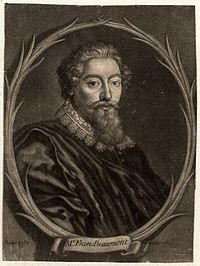Francis Beaumont facts for kids
Quick facts for kids
Francis Beaumont
|
|
|---|---|
 |
|
| Born | 1584 Grace-Dieu, England |
| Died | 6 March 1616 (aged 31–32) London, England |
| Nationality | English |
| Notable works | The Knight of the Burning Pestle |
Francis Beaumont (born 1584 – died March 6, 1616) was a famous writer of plays during the English Renaissance theatre. He is best known for working with another playwright named John Fletcher. Together, they wrote many popular plays.
Contents
Francis Beaumont's Early Life and Education
Francis Beaumont was born in 1584 at Grace Dieu, a place near Thringstone in Leicestershire, England. His father, Sir Francis Beaumont, was a judge. His mother was Anne Pierrepont.
When he was 13, Francis went to Broadgates Hall, which is now Pembroke College, Oxford. After his father passed away in 1598, he left college without finishing his degree. In 1600, he moved to London and joined the Inner Temple, a place where people studied to become lawyers.
Becoming a Playwright
Francis Beaumont did not work as a lawyer for very long. He became friends with famous writers like Ben Jonson and Michael Drayton. He soon decided that writing plays was his true passion.
His first known work was a long poem called Salmacis and Hermaphroditus, which came out in 1602. In 1605, he wrote some special verses for Ben Jonson's play Volpone.
Working with John Fletcher
Beaumont started working with John Fletcher around 1605. Both writers had faced some early struggles with their plays. Beaumont's play, The Knight of the Burning Pestle, was first performed in 1607. Audiences at the time did not understand that it was a funny satire (a play that makes fun of something). They thought it was just an old-fashioned play, so it was not very popular.
However, in 1609, Beaumont and Fletcher worked together on a play called Philaster. This play was performed at the famous Globe Theatre and Blackfriars. Philaster was a huge success! It helped both playwrights become very well-known and started a new trend for plays called tragicomedy, which mix sad and funny parts.
Beaumont and Fletcher were very close friends. They even lived in the same house in London, sharing everything. Around 1613, Beaumont married Ursula Isley. They had two daughters named Elizabeth and Frances.
After 1613, Francis Beaumont stopped writing plays because he became ill. He passed away in 1616 and was buried in Westminster Abbey. Even though he is remembered as a playwright today, he was also celebrated as a poet during his lifetime.
Francis Beaumont's Plays
It was once thought that it was impossible to tell Beaumont's writing apart from Fletcher's in their joint plays. However, experts have studied their works closely and can now often tell who wrote which parts.
Here are some of the plays Francis Beaumont wrote by himself:
- The Knight of the Burning Pestle, a comedy (performed 1607; printed 1613)
- The Masque of the Inner Temple and Gray's Inn, a special kind of play called a masque (performed 1613; printed 1613)
Here are some of the plays he wrote with John Fletcher:
- The Woman Hater, a comedy (1606; 1607)
- Cupid's Revenge, a tragedy (around 1607–1612; 1615)
- Philaster, or Love Lies a-Bleeding, a tragicomedy (around 1609; 1620)
- The Maid's Tragedy, a tragedy (around 1609; 1619)
- A King and No King, a tragicomedy (1611; 1619)
- The Captain, a comedy (around 1609–1612; 1647)
- The Scornful Lady, a comedy (around 1613; 1616)
- Love's Pilgrimage, a tragicomedy (around 1615–1616; 1647)
- The Noble Gentleman, a comedy (licensed 1626; 1647)
Some plays by Beaumont and Fletcher were later changed or added to by another writer named Philip Massinger. These include:
- Thierry and Theodoret, a tragedy (around 1607?; 1621)
- The Coxcomb, a comedy (around 1608–1610; 1647)
- Beggars' Bush, a comedy (around 1612–1613?; revised 1622?; 1647)
- Love's Cure, a comedy (around 1612–1613?; revised 1625?; 1647)
Experts can often tell Beaumont's writing from Fletcher's because Fletcher used certain words and ways of speaking very often. For example, in A King and No King, Beaumont wrote most of the first three acts, while Fletcher wrote smaller parts later in the play.
Images for kids
See also
 In Spanish: Francis Beaumont para niños
In Spanish: Francis Beaumont para niños


